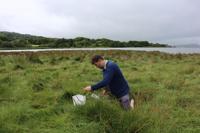“Are you guys really fit? Or are you on e-bikes?” a hiker called out to our small group, as we pedalled past his family on our way toward the peak of Mynydd Carningli. My turquoise electric mountain bike was indeed powered on and set on “boost” mode. Still, I had to laugh that he even debated how we were cycling briskly up a small mountain without breaking a sweat.
The Hidden Routes guided tour, my first time on an e-bike, was a delight, even on a gloomy, drizzly morning. I had anticipated that it would be more eco-friendly than a car or bus excursion, but the best part was being able to go off the beaten path — riding through steep trails, a sessile oak woodland, and overgrown pastures full of grazing sheep — and to see the pretty coastal town of Newport, Pembrokeshire, from new vantage points.
Hotelier and chef Ed Sykes of Llys Meddyg takes travellers out for foraging tours by the seashore.
This summer I travelled to Wales to better understand why it was named a top sustainable travel destination for 2024 by Lonely Planet. The guidebook publisher spotlighted a “rail revamp” that would make exploring the wild west easier without a car, but I soon learned that Wales’ eco-emphasis goes beyond improvements in train service. There are many opportunities for visitors to go green, connect with nature and embrace local perspectives — starting with staying at small boutique hotels run by townspeople.
The day after my ride, I set out on foot for a foraging course offered by the eight-room Llys Meddyg, where I was staying, which also ran the e-bike tour. Hotel co-owner Ed Sykes, also a chef, has been leading these tours for 12 years, teaching guests about the timing and uses for wild ingredients like laver (the seaweed used to make laver bread), marsh samphire and stinging nettle.
“I’ll show you what we’ve got on our doorstep,” says Sykes, as we set off to see the hedgerows and mud flats. On our walk towards the water and along the seashore, we stopped often — to taste a puckery sorrel leaf, pluck juicy blackberries and rosehips, harvest a handful of sea arrow-grass — and made small detours whenever something caught Sykes’ trained eye.
It was a different, and at times meditative, way to experience the town’s coastline, which I had walked along the day before, following the iconic Wales Coast Path. “I think through plants you get a good sense of where you are,” says Sykes.

Some of the wild ingredients foraged in Newport, Pembrokeshire.
That awareness of place stayed with me as I headed east to Cardigan Bay, the largest bay on the Welsh coast, and a popular destination for dolphin watching year-round.
On a cruise with New Quay Boat Trips, I spotted seabirds and a handful of dolphins, and learned about the code of conduct protecting the marine mammals and seabird colonies within this special conservation area from would-be pursuers and speeding boats. Beyond sandy beaches and picture-perfect seaside villages, this bay is also home to the largest population of bottlenose dolphins in Europe.
My last stop along the Pembrokeshire coast brought me to St Davids, home to the historic St Davids Cathedral. In this small city, I visited two neighbouring attractions that, to me, exemplified Wales’ rising focus on all things local and sustainable.

The historic St Davids Cathedral in the small city of St Davids.
Opened in 2016, Dr. Beynon’s Bug Farm is part research centre, part unusual tourist attraction. Without insects, “the rest of the environment would fall apart,” explains founder Dr. Sarah Beynon, a conservationist, farmer and academic ecologist. “They make up 80 per cent of all animal species on Earth, and we know so little about them.”
There are no bugs being farmed here, despite the name, but I found educational displays speaking to the ecological benefits of eating insects and a small “zoo” of insects from around the world. There is also a café and restaurant, where I tried my first “insect and plant mince” burger, happily munched on curried roast crickets, and bought chocolate chip cricket cookies to bring home.
Less than a kilometre away is the award-winning, sustainability-minded Old Farmhouse Brewery, located on a working pedigree beef farm. Co-owner Emma Evans told me about the story behind each of the brewery’s seven beers, all made and bottled on-site using well water and malting barley from the farm. “They’re all connected to the local area, or we try to use local ingredients where we have them,” Evans says.
I sampled two brews, including a pale gold lager that incorporates kelp from nearby Câr y Môr, a community-owned seaweed and shellfish farm, and mulled over their hyperlocal origins and distinctive profiles — flavours I won’t find anywhere else.
Sometimes travel can feel like a race to check off as much as possible, as quickly as possible. In Wales, I understood the benefits of going slower, and stopping to smell the rosehips.
Truc Nguyen travelled as a guest of VisitBritain, which did not review or approve this article.



